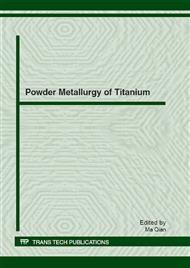[1]
Heaney, D.F., Qualification Method For Powder Injection Molded Components. P/M Science & Technology Briefs, 2004. 6(3): pp.21-27.
Google Scholar
[2]
Whychell, D., The Effect of Powder Particle Size and Alloying Technique on Distortion in MIM Parts, in A collection of technical literature on Powder Injection Moulding, MPIF, Editor. 2007, Metal Powder Industries Federation: Princeton, NJ. pp.92-104.
DOI: 10.1016/s0026-0657(02)80224-7
Google Scholar
[3]
Haack, J., et al., The Processing of Biomaterials for Implant Applications by Powder Injecton Moulding. Powder Injection Moulding International, 2010. 4(2): pp.49-52.
Google Scholar
[4]
Herranz, G., et al., Metal injection moulding of bronze using thermoplastic binder based on HDPE. Powder Metallurgy, 2007. 50(2): pp.184-188.
DOI: 10.1179/174329007x169155
Google Scholar
[5]
Schofalvi, K., Low Contamination Binders for Reaction Sensitive Alloy Applications, in A collection of technical literature on Powder Injection Moulding, MPIF, Editor. 2007, Metal Powder Industries Federation: Princeton, NJ. pp.126-130.
Google Scholar
[6]
Schwartz, S., P. Quirmbach, and M. Kraus, Solvent Debinding Technology for a Continuous 316L MIM Production, in A collection of technical literature on Powder Injection Moulding, MPIF, Editor. 2007, Metal Powder Industries Federation: Princeton, NJ. pp.147-155.
Google Scholar
[7]
German, R., Powders, binders and feedstocks for powder injection moulding. Powder Injection Moulding International, 2007. 1(1): pp.34-39.
DOI: 10.1016/0026-0657(96)93948-x
Google Scholar
[8]
Thian, E.S., et al., Ti-6A1-4V/HA composite feedstock for injection molding. Materials Letters, 2002. 56(4): p.522–532.
DOI: 10.1016/s0167-577x(02)00544-x
Google Scholar
[9]
Ewart, P.D., et al., Encapsulation of titanium powders during binder removal from a metal injection moulded part. Advances in Powder Metallurgy & Particulate Materials, 2011: pp.172-183.
Google Scholar
[10]
Herranz, G., et al., Development of new feedstock formulation based on high density polyethylene for MIM of M2 high speed steels. Powder Metallurgy, 2005. 48(2): pp.134-138.
DOI: 10.1179/003258905x37828
Google Scholar
[11]
Ferri, O., T. Ebel, and R. Bormann, High cycle fatigue behaviour of Ti–6Al–4V fabricated by metal injection moulding technology. Materials Science and Engineering: A, 2009. 504(1-2): p.107–113.
DOI: 10.1016/j.msea.2008.10.039
Google Scholar
[12]
Li, Y., X. Chou, and L. Yu, Dehydrogenation debinding process of MIM titanium alloys by TiH2 powder. Powder Metallurgy, 2006. 49(3): pp.236-239.
DOI: 10.1179/174329006x95338
Google Scholar
[13]
Ewart, P.D., et al., Powder Injection Molding of Multi-scale Titanium Parts - Micro Features and Surface Modification, in PowderMet2011, International Conference on Powder Metallurgy & Particulate Materials. 2011: San Francisco, California.
Google Scholar
[14]
Ewart, P.D., S. Ahn, and D. Zhang, Injection moulding titanium powders; feedstock compounding, homogeneity and handling strength. Powder Injection Moulding International, 2011. 5(2): pp.54-59.
Google Scholar
[15]
German, R. and A. Bose, Injection Molding of Metals and Ceramics. 1997, Princeton: Metal Powder Industries Federation. 413.
Google Scholar
[16]
Ismail, M.H., et al., Study of Evolution of Pore Structure during Water Leaching using PEG-PMMA Binder System, in A collection of technical literature on Powder Injection Moulding, MPIF, Editor. 2007, Metal Powder Industries Federation: Princeton, NJ.
Google Scholar
[17]
Atre, S. and R. German, Quantitative Analysis of Thermal Debinding, in A collection of technical literature on Powder Injection Moulding, MPIF, Editor. 2007, Metal Powder Industries Federation: Princeton, NJ. pp.23-34.
Google Scholar
[18]
Park, S., et al., Rheological and Thermal Debinding Behaviors in Titanium Powder Injection Molding. Metallurgical and Materials Transactions A, 2009. 40: pp.215-222.
DOI: 10.1007/s11661-008-9690-3
Google Scholar
[19]
Grohowski, J. and J. Strauss, Effect of Atmosphere Type on Thermal Debinding, in A collection of technical literature on Powder Injection Moulding, MPIF, Editor. 2007, Metal Powder Industries Federation: Princeton, NJ. pp.137-144.
Google Scholar
[20]
Lee, H., G. Shu, and K. Hwang, Effect of Particle Size on the Debinding of PIM Parts, in A collection of technical literature on Powder Injection Moulding, MPIF, Editor. 2007, Metal Powder Industries Federation: Princeton, NJ. pp.147-153.
Google Scholar
[21]
Shengjie, Y., et al., Simulation of Thermal Debinding, in A collection of technical literature on Powder Injection Moulding, MPIF, Editor. 2007, Metal Powder Industries Federation: Princeton, NJ. pp.117-128.
Google Scholar
[22]
Schlieper, G., Back to basics: from the injection moulding machine to the debinding oven. Powder Injection Moulding International, 2010. 4(3): pp.50-53.
Google Scholar
[23]
Bono, R.W., New Methodology of Resonant Inspection Applied to Metal Injecton Moulded Parts. Powder Injection Moulding International, 2010. 4(2): pp.53-56.
Google Scholar
[24]
Ewart, P.D., et al., Powder Injection Molding of Multi-scale Titanium Parts - Micro Features and Surface Modification, in PowderMet2011, International Conference on Powder Metallurgy & Particulate Materials. 2011: San Francisco, California.
Google Scholar


